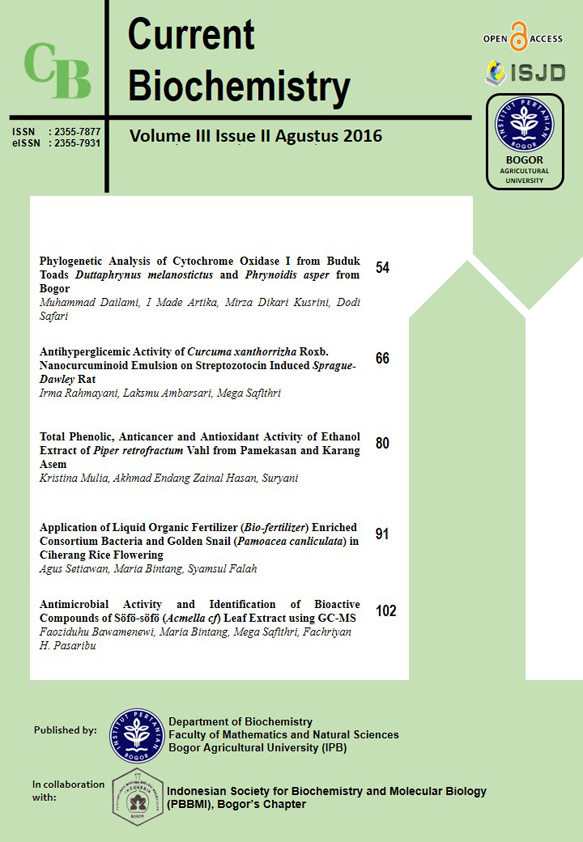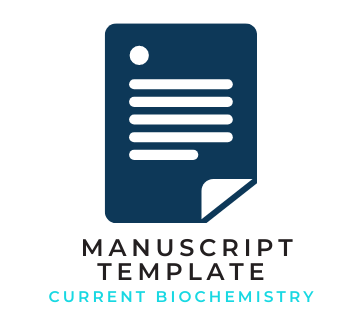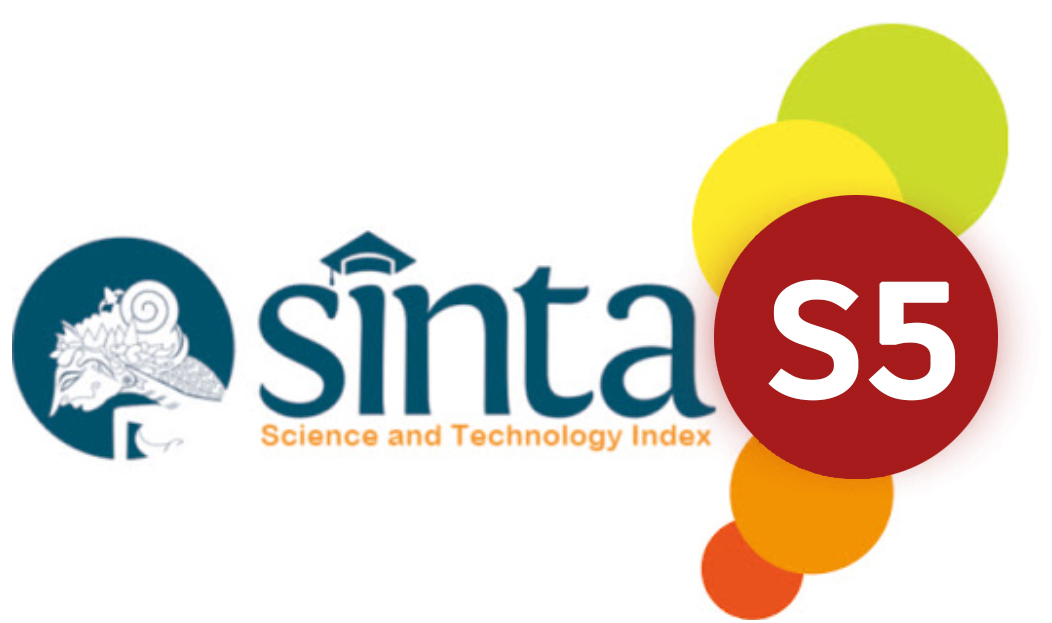Phylogenetic Analysis of Cytochrome Oxidase I from Buduk Toads <i>Duttaphrynus melanostictus</i> and <i>Phrynoidis asper</i> from Bogor
Abstract
Indonesia have high diversity of Amphibians. Amphibians have an important role in ecosystem and produce many bioactive peptides. However, the genetic information of amphibians from Indonesia is very limited, especially Duttaphrynus melanostictus and Phrynoidis asper. The aims of this study are to determine the nucleotide sequence of cytochrome oxidase I (COI) from D. melanostictus and P. asper, to analyze their genetic diversity and their phylogenetic relationship. A total 668 base pairs of COI gene fragment were successfully amplified and their nucleotide sequence determined. P. asper (5 haplotypes) samples group have high haplotype diversity compared to D. melanostictus (1 haplotype). The results of Basic Local Alignment Search Tools (BLAST) to the NCBI and BOLD database, showed 99 % - 100 % identity to sequence of D. melanostictus. For the sequence of P. asper showed 99.23 % identity to sequence P. asper in BOLD database. There was no sequence of COI gene of P. asper in NCBI database. Genetic relationship among species in family Bufonidae, indicated that D. melanostictus has closer relation to P. asper than to another species, inspite of their pharapyletic characteristic. For intern species relationship of D. melanostictus, the data showed that D. melanostictus from Bogor have closer relationship to D. melanostictus from India than D. melanostictus from China.
References
Arian P, Artika IM, Falah S. 2016. Amplification and analysis of cytochrome oxidase I of Polypedates leucomystax from Bogor Agricultural University Area. Curr Biochem 3: 13-19
Artika IM, Pinontoan S, Kusrini MD. 2015a. Antifungal activity of skin secretion of bleeding toad Leptophrine cruentata and javan tree frog Rachophorus margaritifer. Am J Biochem Biotechnol 11: 5-10
Artika IM, Pinontoan S, Kusrini MD. 2015b. Antifungal activity of skin secretion of bleeding toad Leptophrine cruentata and javan tree frog Rachophorus margaritifer. Am J Biochem Biotechnol 11: 127-131
BAPPENAS (Badan Perencanaan Pembangunan Nasional). 1993. Biodiversity Action Plan for Indonesia. Jakarta: Ministry of National Development Planning/National Development Planning Agency. 141 p.
Brown WM, George MJR, Wilson AC. 1979. Rapid evolution of animal mitochondrial DNA. (primates/restriction endonuclease cleavage maps/gel electrophoresis/DNA melting). Proceeding Natural Academi of Science. USA. Genetics. 76(4):1967-1971.
Che J, Chen HM, Yang JC, Jin JQ, Jiang K, Yuan ZY, Murphy RW, Zhang YP. 201111. Universal COI primers for DNA barcoding amphibians. Molecular Ecology Resources. doi: 10.1111111111111111/j.1755-0998.201111. 03090.
Da Fonseska RR, Johnson WE, Brien SJ, Ramos MJ, Antunes A. 2008. The adaptive evolution of the mammalian mitochondria genome. BMC Genomic. doi:10.111186/1471-2164-9-11119.
Dailami M, Artika IM, Kusrini MD, Safari D. 2016. Analysis and prediction of some histone-derived antimicrobial peptides from toads Duttaphrynus melanostictus and Phyrinoidis asper. The Journal of Pure and Applied Chemistry Research. 5(2): 67-76, ISSN 2302-4690.
Frost DR, Grant T, Faivovich J, Bain RH, Has A, Haddad CLFB, De Sa’ RO, Channing A, Wilkinson M, Donnellan SC, Raxworthy CJ, Campbell JA, Blotto BL, Moler P, Drewes RC, Nussbaum RA, Lynch JD. 2006. The amphibian tree of life. Bulletin of the American Museum of Natural History. No. 297. 370 pp.
García-Muñoz E, Gilbert JD, Parra G, Guerrero F, 2010. Wetlands classification for amphibian conservation in Mediterranean landscapes. Biodiversity Conservation. 19(3): 901–91111.
Graybeal A. 1997. Phylogenetic relationships of bufonid frogs and tests of alternate macro-evolutionary hypotheses characterizing their radiation. Zoological Jouma1 of the Linnean Society. 11119:297-338
Hebert PDN, Cywinska A, Ball SL, deWaard JR. 2003.Biological identifications through DNA barcodes. Proceedings of the Royal Society London B, 313-321.
Hutchison CA, Newbold JE, Potter SS, Edgell MH. 1974. Maternal inheritance of mammalian mitochondrial DNA. Nature. 251:536–8.
Inger RF, Voris HK, Voris HH. 1974. Genetic variation and population ecology of some Southeast Asian frogs of the genus Bufo and Rana. Biochemical Genetics, 12(2), 121-145.
Kusrini MD. 2007. Konservasi Amfibi Di Indonesia: Masalah Global Dan Tantangan. Media Konservasi. XII(2):89-95.
Nei M dan Kumar S. 2000. Molecular Evolution and Phylogenetics. New York: Oxford University Press.
Pukala TL, Bowie JH, Maselli VM, Musgrave IF, Tyler MJ. 2006. Review: Host-defence peptides from the glandular secretions of amphibians: structure and activity. Natural Product Reports. doi: 10.1039/b51211118n.
Sambrook J, Fritsch EF, Maniatis T. 1989. Molecular Cloning: A Laboratory Manual (2nd Ed.). 10.51-10.67.
Solihin DD. 1994. Peranan DNA mitokondria dalam studi keragaman genetik dan biologi populasi pada hewan. Jurnal Hayati. 1(1):1-4, ISSN 0854-8587.
Tamura K, Stecher G, Peterson D, Filipski A, Kumar S. 201111. MEGA5: Molecular Evolutionary Genetics Analysis using maximum likelihood, evolutionary Distance and Maximum Parsimony methods. Molecular Biology and Evolution. 28: 2731-2739.
Xu X and Lai R. 2015. The chemistry and biological activities of peptides from amphibian skin secretions. Chemical Reviews. 11115 (4):1760-1846. doi: 10.1021/ cr4006704.
Zhang P, Zhou H, Chen YQ, Liu YF, Qu LH. 2005. Mitogenomic perspectives on the origin and phylogeny of living amphibians. Systematics Biology. 54(3):391–400, doi: 10.1080/10635150590945278.










